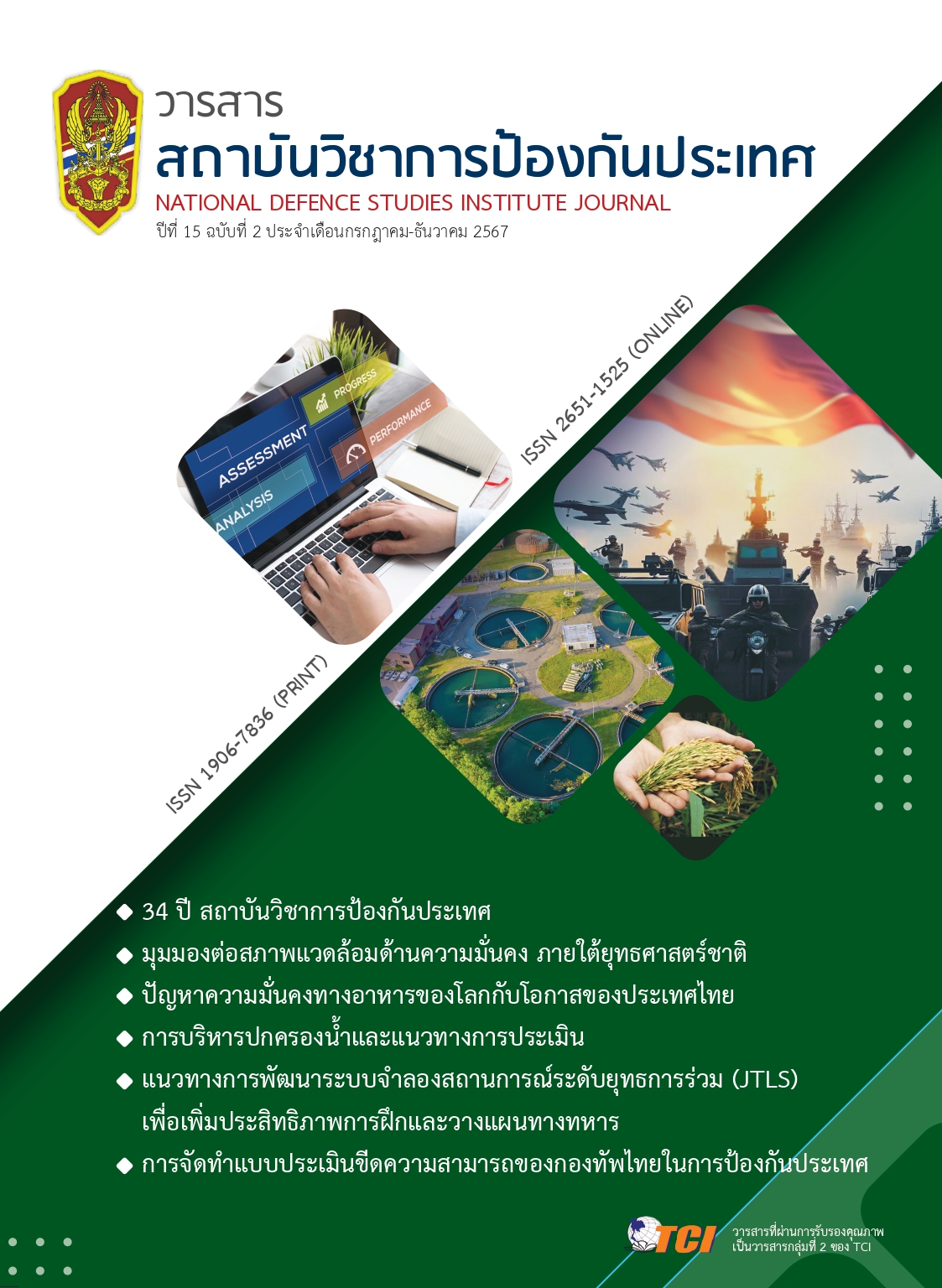The Development of an Assessment of the Capability of the Royal Thai Armed Forces in National Defence
Main Article Content
Abstract
This research investigates the development of a capability assessment for the Royal Thai Armed Forces in national defence. It has three objectives: 1) to study the principles and concepts of capability for the Royal Thai Armed Forces in national defense; 2) to identify a suitable capability assessment model; and 3) to provide recommendations for developing and implementing such an assessment. This qualitative study employed brainstorming and focus group discussions to gather data from military experts, academics specializing in performance indicators, and military officers at the policy level within the Ministry of Defence, the
Royal Thai Armed Forces Headquarters, and the Royal Thai Army, Navy, and Air Force.
The study examined capability frameworks from three countries: 1) the US Department of Defense’s DOTMLPF-P Domain framework; 2) the UK’s Defence Lines of Development (DLOD) framework; and 3) the Australian Defence Force’s Fundamental Input Capability (FIC) framework. Analysis revealed key factors for assessing desired capabilities in national defense for each service. The Royal Thai Army identified ten factors: doctrine, organization, training, material, leadership, personnel, facilities, logistics, policies, and industry. The Royal Thai Navy identified five factors: material & equipment, personnel, logistics & support, doctrine & training, and enterprise architecture. The Royal Thai Air Force identified eight factors: doctrine, training, equipment, command & management, personnel, logistics, information, and space & cyber. The Royal Thai Armed Forces Headquarters and the Ministry of Defence identified eleven factors: doctrine, organization and management, training, material and equipment, leadership and interoperability, personnel, facilities, sustainability, policy and command, information and cybersecurity, and defense industry and suppliers.
Based on these findings, seven key factors are recommended for developing a comprehensive capability assessment: concepts, force structure, personnel and leadership, equipment, logistics and facilities, training, and command & control and management. This research aims to provide the Royal Thai Armed Forces with a standardized
capability assessment model applicable across all branches. This model will enable the evaluation of individual service capabilities and overall readiness to address various threats, support national strategic objectives for armed forces readiness, and contribute to Thailand’s military ranking in Global Firepower Index.
Article Details

This work is licensed under a Creative Commons Attribution-NonCommercial-NoDerivatives 4.0 International License.
The articles, images, tables, graphs, written content, and opinions published in this journal are solely those of the authors and do not necessarily reflect the views or positions of the National Defence Studies Institute or its academic affiliates.
References
วิทยาลัยการทัพบก. (2561). การปฏิบัติการทางทหารนอกเหนือการสงคราม. สืบค้นจาก http://www.geocities.ws/cgscsos/Mootw2.pdf
สำนักงานคณะกรรมการพัฒนาระบบราชการ. (2553). คู่มือการประเมินผลการปฏิบัติราชการตามคำรับรองประจำปีงบประมาณ. สืบค้นเมื่อ 13 มีนาคม 2566, จาก https://www.opdc.go.th/content/filelist/MTMz
สถาบันวิชาการป้องกันประเทศ, ศูนย์ศึกษายุทธศาสตร์. (2566). การจัดทำแบบประเมินขีดความสามารถของกองทัพไทยในการป้องกันประเทศ (เอกสารวิจัย).
สำนักงานคณะกรรมการพัฒนาเศรษฐกิจและสังคมแห่งชาติ, สำนักงานเลขานุการของคณะกรรมการยุทธศาสตร์ชาติ. (2562). ยุทธศาสตร์ชาติ พ.ศ. 2561-2580. กรุงเทพฯ.
Australian Government Department of Defence. (2012). Defence Capability Manual. Retrieved September 20, 2022 from http://www.defence.gov.au/business-industry/industry-governance/defencecapability-manual
Global Fire Power. (2023). Military Strength Ranking. Retrieved January 10, 2023 from https://www.globalfirepower.com/countries-listing.php
UK Ministry of Defence. (2010). Defence Line of Development. Retrieved January 10, 2023 from http://trak-community.org/index.php/wiki/Defence_Line_of_Development
United States Army. (2018). The U.S. Army in Multi-Domain Operations 2028. Retrieved January 7, 2023 from https://adminpubs.tradoc.army.mil/pamphlets/TP525-3-1.pdf


